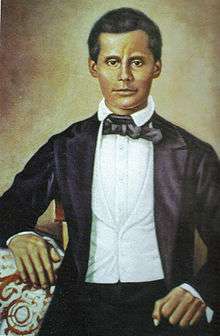Francisco del Rosario Sánchez

Francisco del Rosario Sánchez (March 9, 1817 – July 4, 1861) was a politician and founding father of the Dominican Republic. He is considered by Dominicans as the second leader of the 1844 Dominican War of Independence, after Juan Pablo Duarte and before Ramón Matías Mella. The Order of Merit of Duarte, Sanchez and Mella is named in honor of these men. He was the son of Olaya del Rosario Belén (1791–1849), a white woman of Canarian descent, and Narciso Sánchez Ramona (1789–1869), a pardo (triracial) man; his surnames are inverted because his parents were not married at the time of his birth, marrying in 1819.
Sánchez traveled to the U.S. and Europe as a young man. His vision of the cause was the typical republican goal of the Age of Enlightenment. Duarte's exile took place at the last and most crucial stage of the struggle. It was when Duarte was exiled and in hiding in Venezuela that Sánchez became the central presence in the Dominican revolt.
Sánchez took the lead as the prime mover of the independence movement, maintaining contact with Duarte through his relatives. While educated and having taught himself Latin and French later in life, he is mostly remembered as a man of action. In the proceedings that took place just before the proclamation of independence on February 27, 1844, Sánchez was elected by his peers in La Trinitaria as Commander in Arms and Chief of the Government Junta in the nascent republic. This was quite a recognition and a testament to his virtues.
After a brief period of turmoil and quick political succession, Pedro Santana exiled the main architects of the independence. Sánchez spent four years in exile and was eventually pardoned. He returned to the Dominican Republic in time to see Santana invite Spain to re-occupy the country as colony. Sánchez led a force in an attempt to overthrow Santana, but was captured by Santana's forces and executed in 1861.
He is entombed in a mausoleum, Altar de la Patria, at the Count's Gate (Puerta del Conde) alongside Duarte and Mella, at the location of the start of the War of Independence.